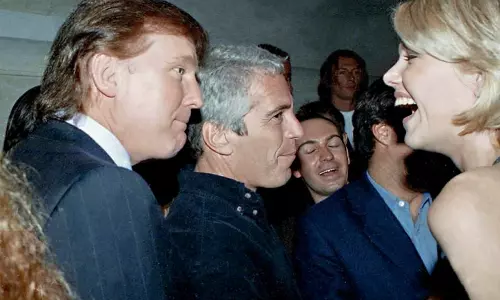
Historic UN biodiversity accord text published with 2030 goal
text_fieldsMontreal: The historic Kunming-Montreal Global Biodiversity Framework, which includes a goal to prevent and reverse biodiversity loss, was adopted by 196 parties at the 15th Conference of Parties (COP15) to the UN Convention on Biological Diversity after two days of negotiations.
The framework, which was unveiled on Thursday in Canada's second-largest city by population, consists of four goals and 23 targets that must be met by 2030.
Responding to final Kunming-Montreal Global Biodiversity Framework, WWF International Director General Marco Lambertini, told IANS: "Agreeing a shared global goal that will guide collective and immediate action to halt and reverse nature loss by 2030 is an exceptional feat for those that have been negotiating the Global Biodiversity Framework, and a win for people and planet."
"It sends a clear signal and must be the launchpad for action from governments, business and society to transition towards a nature-positive world, in support of climate action and the Sustainable Development Goals."
Saying it was taken time to get here but governments have signed a once-in-a-decade agreement to halt the destruction of earth's ecosystems and to protect people and species, Jennifer Morris, The Nature Conservancy, CEO, said, "We were looking for a global agreement that would transform our relationship with nature."
"Agreeing to halt and reverse nature loss by 2030 puts the issue squarely on the table with a clear deadline for all of society. If implementation moves at pace, and funding flows where its needed then we can look back on this snowy historic day in Montreal and say yes, I remember the moment when humanity decided to put nature first."
The framework has four long-term goals for 2050 related to the 2050 Vision for Biodiversity.
Goal A
The integrity, connectivity and resilience of all ecosystems are maintained, enhanced, or restored, substantially increasing the area of natural ecosystems by 2050;
Human induced extinction of known threatened species is halted, and, by 2050, extinction rate and risk of all species are reduced tenfold and the abundance of native wild species is increased to healthy and resilient levels;
The genetic diversity within population of wild and domesticated species is maintained, safeguarding their adaptive potential.
Goal B
Biodiversity is sustainably used and managed and nature's contribution to people, including ecosystem functions and services, are valued, maintained and enhanced, with those currently in decline being restored, supporting the achievement of sustainable development for the benefit of present and future generations by 2050.
Goal C
The monetary and non-monetary benefits from the utilisation of genetic resources, and digital sequence information on genetic resources, and of traditional knowledge associated with genetic resources, as applicable, are shared fairly and equitably, including, as appropriate with indigenous peoples and local communities, and substantially increased by 2050, while ensuring traditional knowledge associated with genetic resources is appropriately protected, thereby contributing to the conservation and sustainable use of biodiversity, in accordance with internationally agreed access and benefit-sharing instruments.
Goal D
Adequate means of implementation, including financial resources, capacity-building, technical and scientific cooperation, and access to and transfer of technology to fully implement the Kunming-Montreal Global Biodiversity Framework are secured and equitably accessible to all parties, especially developing countries, in particular the least developed countries and small island developing states, as well as countries with economies in transition, progressively closing the biodiversity finance gap of $700 billion per year, and aligning financial flows with the Kunming-Montreal Global Biodiversity Framework and the 2050 Vision for Biodiversity.
The framework has 23 action-oriented global targets for urgent action over the decade to 2030. The actions set out in each target need to be initiated immediately and completed by 2030.
Together, the results will enable achievement towards the outcome-oriented goals for 2050.
Actions to reach these targets should be implemented consistently and in harmony with the Convention on Biological Diversity and its protocols and other relevant international obligations, taking into account national circumstances, priorities and socio-economic conditions.
Responding to the Kunming-Montreal Global Biodiversity Framework, campaign group Avaaz said a new chapter has begun.
"The result of COP15 opens a new chapter of hope in the fight to keep our world a liveable place for all, Avaaz Acting CEO, Bert Wander, told IANS.
"Implementing this deal will require increased and sustained mobilisation. We won't have much time to breathe: the work has to start right away. These outcomes open a new chapter where there will be much to do on implementation, and to further strengthen the implementation mechanisms at the Convention on Biological Diversity."
Avaaz sees the global biodiversity framework as a blueprint to guide collective effort, but also vigilance, to stop biodiversity loss.
Countries will now have to update their national biodiversity strategies and action plans to reflect the global biodiversity framework and how they will contribute to achieving it.
This must happen as soon as possible and before COP16 (Antalya in Turkey in 2024), when a first assessment of the level of global ambition will take place.
The development and implementation of these plans opens up formidable opportunities for people to mobilise in all countries.
There is a funding need of nearly $1 trillion a year to implement the global biodiversity framework .
As per Avaaz, the final text used a smaller number, but still estimated the funding gap to fill at $700 billion per year.
With 196 nations, the UN Convention on Biological Diversity has near universal participation among countries. The convention seeks to address all threats to biodiversity and ecosystem services.
With inputs from IANS























